Visiting Ephesus is one of the best things to do in Turkey and is high on the list of many travelers to this beautiful country. Its ancient ruins attract more than 2 million visitors. You can visit Ephesus in one morning, but the city of Selçuk, just outside the archaeological site, also has many things to do. This Ephesus travel guide will give you all the practical information you need to make the most of your trip to the ruins of ancient Ephesus, such as where to stay, the best tours and activities, the main sights to see in Ephesus, and much more.
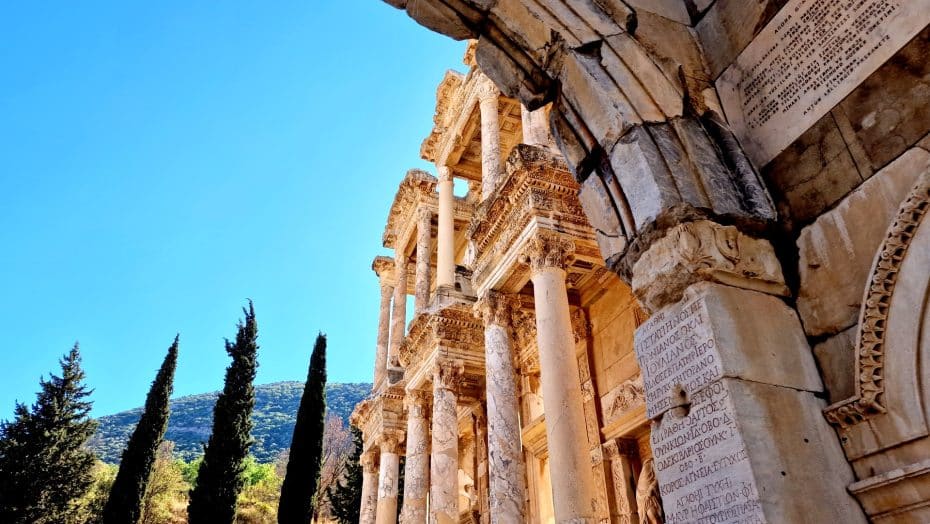
Ancient Ephesus was once a thriving port city on the banks of the Kaystros River. This Greco-Roman metropolis was built around the Temple of Artemis (one of the 7 Wonders of the Ancient World) and grew to become the capital of the Eastern Roman Empire. The whole archaeological complex, including the Temple of Artemis, the House of the Virgin Mary, and the ruins of Ephesus, was inscribed as a UNESCO World Heritage Site in 2015.
This Ephesus travel guide will uncover the best things to do in Ephesus, how to visit the Ephesus Archaeological Site on your own or a tour, and many other travel tips.
Visiting Ephesus: Brief History of Ephesus
Ephesus was an ancient port city whose well-preserved ruins are in present-day Turkey. The city was once considered the most important Greek city and the busiest commercial center in the Mediterranean.
Throughout history, Ephesus survived multiple attacks and changed hands many times between its conquerors. It is also considered one of the cradles of Christianity and remains an important archaeological site and Christian pilgrimage destination.
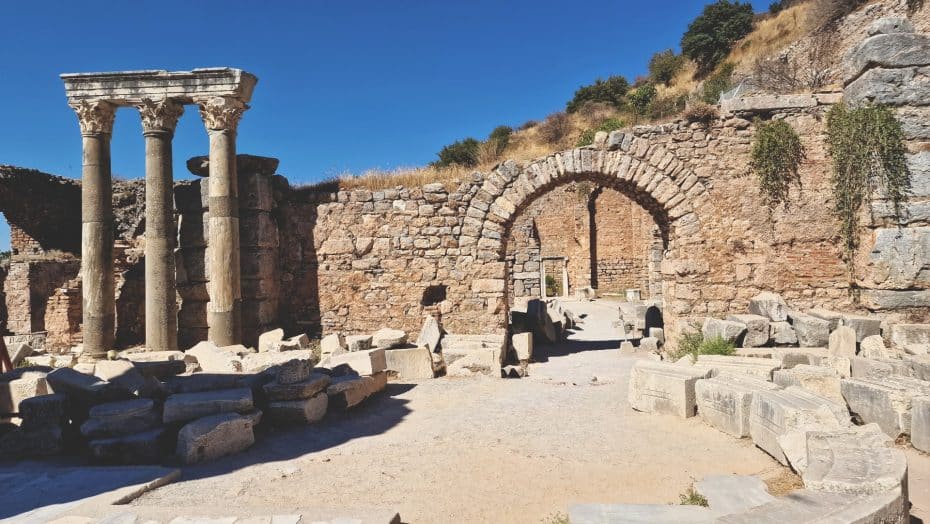
According to legend, the Ionian prince Androclos founded Ephesus in the 11th century BC. Legend has it that while Androclos was searching for a new Greek settlement, he turned to the oracles of Delphi for guidance. The prophets told him that a boar and a fish would show him the new location.
One day, while Androclos was frying fish, one of the fish fell out of the pan and landed in nearby bushes. A spark from the fire lit the bushes, from which a boar ran. Remembering the wisdom of the oracles, Androclos built his new settlement where the bushes were and named it Ephesus.
Another legend says that the Amazons, a tribe of warrior women, founded Ephesus and named the city after their queen, Ephesia.
Much of Ephesus’ ancient history has been lost over the centuries. We know for sure that it fell under the rule of the Lydian kings in the 7th century BC. and became a prosperous city.
The Lydian king Croesus is famous for financing the reconstruction of the Temple of Artemis. Artemis was the goddess of hunting, chastity, childbirth, wild animals, and the desert. In 356 BC, a man burned down the Temple of Artemis. The Ephesians rebuilt it even larger. It is estimated to have been about four times the size of the Parthenon and became known as one of the Seven Wonders of the World.
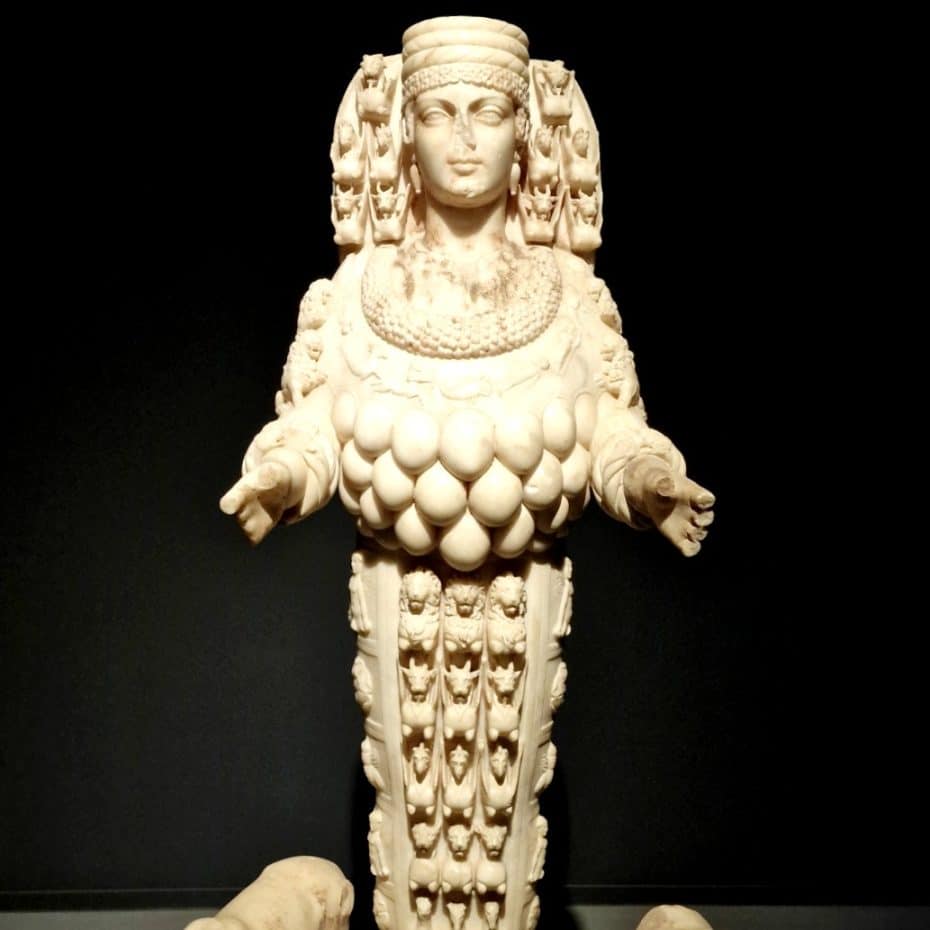
In the 6th century BC, Ephesus fell under the Persian Empire until, in 334 BC, Alexander the Great defeated the Persians and entered the city.
In 263 BC, Ephesus fell under Egyptian rule. The Seleucid king Antiochus III recaptured Ephesus in 196 BC; however, after being defeated at the Battle of Magnesia six years later, Ephesus fell under the rule of Pergamon.
In 129 BC C., King Attalos of Pergamon left Ephesus to the Roman Empire in his will, and the city became the seat of the regional Roman governor. Caesar Augustus’s reforms brought Ephesus into its most prosperous age, which lasted until the 3rd century AD.
Most of the ruins of Ephesus that can be seen today, such as the huge amphitheater, the Library of Celsus, the Agora, and the aqueducts, were built during the regime of Augustus.
According to some sources, Ephesus came to occupy second place (after Rome) as a cosmopolitan center of culture and commerce.
Ephesus played a vital role in the spread of Christianity. Beginning in the 1st century AD, notable Christians such as Saint Paul and Saint John visited the city, winning many Christian converts in the process. It is believed that Mary, the mother of Jesus, spent her last years in Ephesus with Saint John. Her house and John’s burial place can be visited there today.
In AD 262, the Goths destroyed Ephesus, including the Temple of Artemis. Some restoration of the city was carried out, but it never recovered its splendor. In the year 431 AD, a council was held in the Church Mary, which confirmed the Virgin Mary as the mother of God.
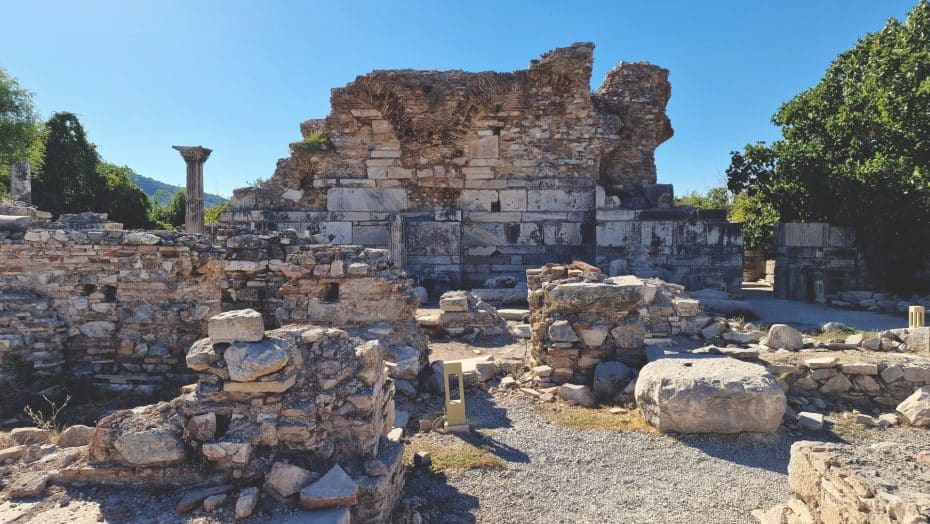
The city relied heavily on its iconic places of worship to attract visitors and its port for trading. However, the rise of Christianity and a deteriorating harbor due to the silting of its river contributed to its decline.
In the 6th and 7th centuries AD, a major earthquake and the continuing decline of the port left Ephesus a shell of the city it used to be, and Arab invasions forced most of the population to flee to other settlements in Anatolia.
The Ottoman Empire took definite control of Ephesus in the 15th century; however, the city was in dire straits, and its port was virtually useless. At the end of that century, Ephesus was finally abandoned.
What to See in Ephesus – The Most Spectacular Ruins in Turkey
There are several unique things to do and see in Ephesus, including the iconic Library of Celsus, the Great Theater, its ancient main street, and the incredible frescoes and mosaics in its Terrace Houses.
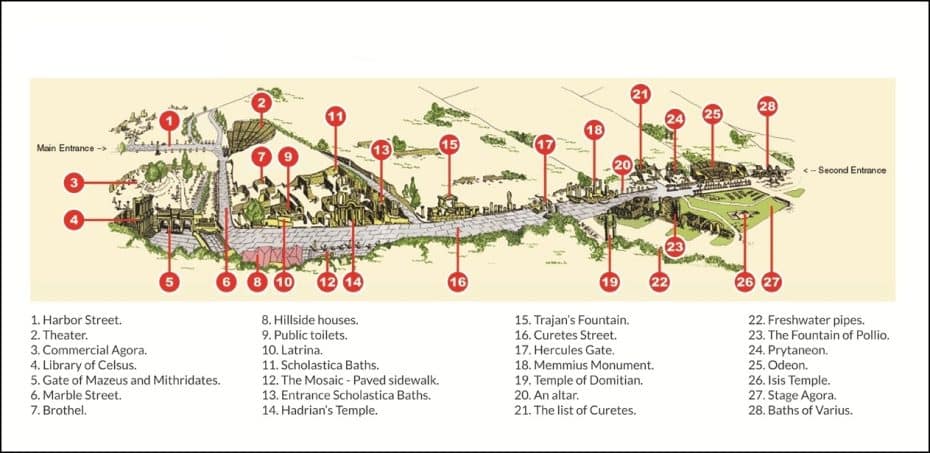
The ruins of the ancient city of Ephesus are spread over an area of 1,500 acres and have two main entrances: one at the top and one at the bottom. Here is a list of Ephesus attractions if accessed from the Upper Gate (to the right on the map).
1. Baths of Varius
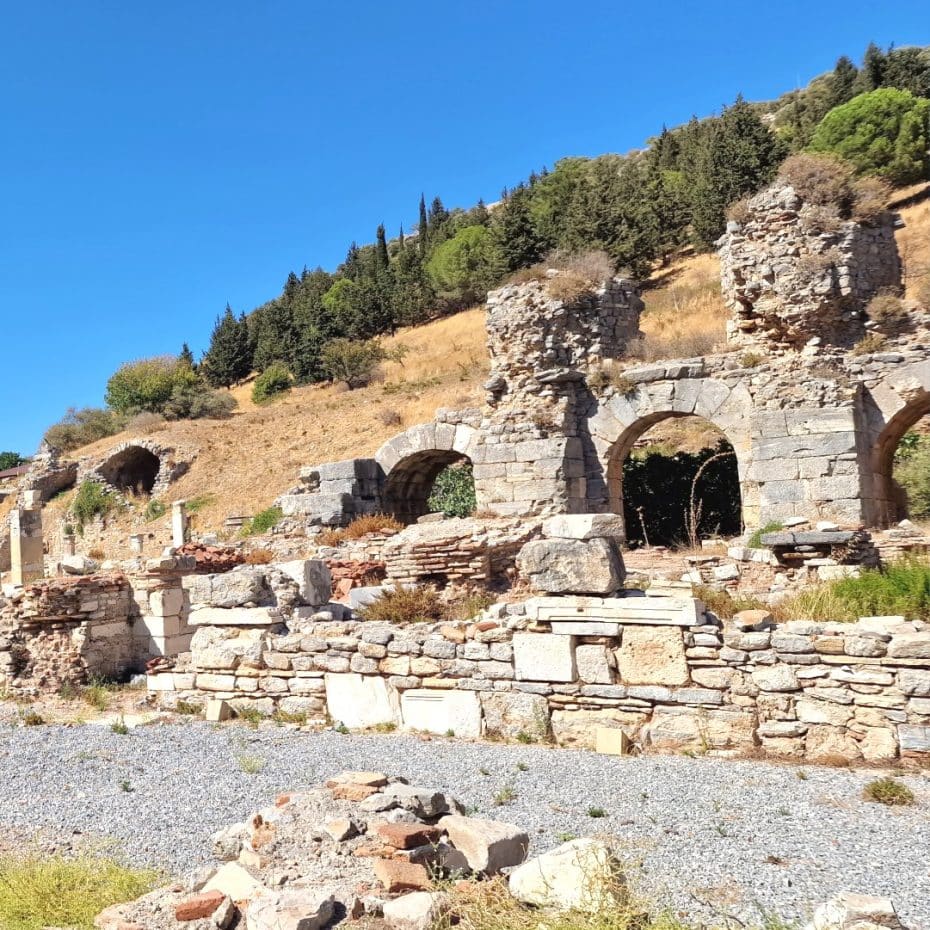
The Baths of Varius were built by the Roman patrician Varius for the Ephesian people and are located in the upper part of Ephesus.
The design of the bathroom is classical Roman, with a caldarium (hot area), a tepidarium (warm area), and a frigidarium (cold area).
These baths were built in the 1st century AD. and destroyed in the VII AD.
The Baths of Varius cover a large area. The building is in fairly good condition up to the vault section. Beyond the three bathing pools, the baths feature a hypocaust to heat the water and public areas that would have been used for socializing.
2. State Agora
The State Agora is the second Agora of Ephesus.
Dedicated to government meetings, this is where political issues were discussed, and it was open to the public. Women and slaves could attend the meetings held here.
3. Odeon
The Odeon is a theater located in the upper part of Ephesus.
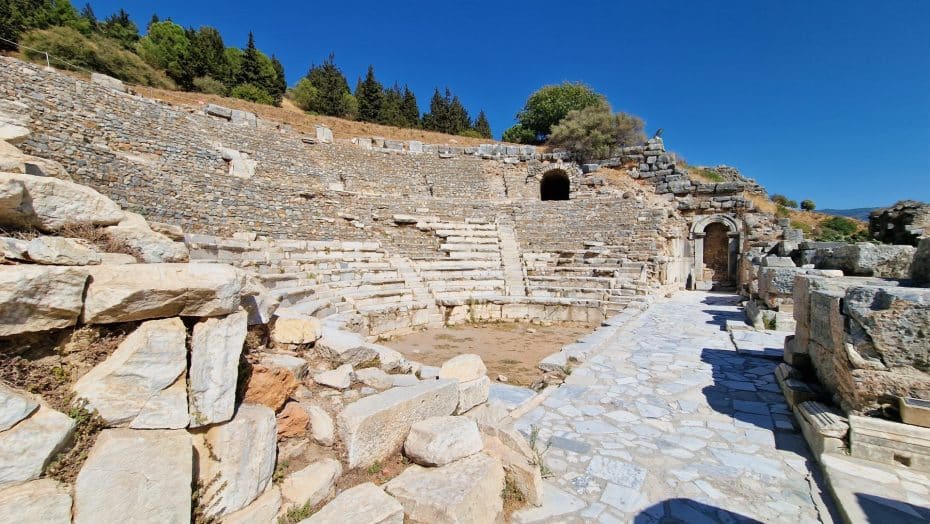
It was built by the Romans and is well preserved. It has a capacity of 1,400-1,800 people and was used as a concert hall and parliament. Due to its proximity to the State Agora, this is where many city council meetings were held.
The building is about 2,000 years old and was destroyed in the earthquake of the 7th century AD.
4. Prytaneon
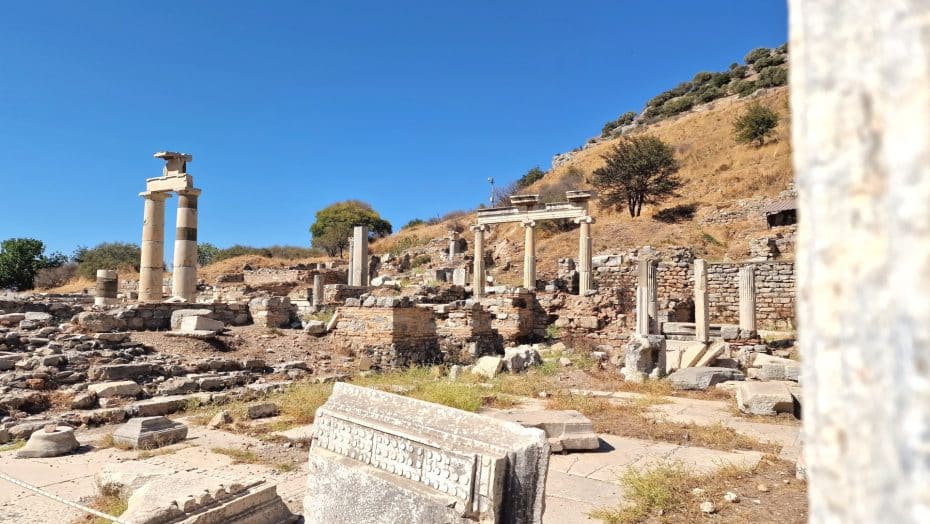
The Prytaneion served as the town hall and headquarters of the local administration of Ephesus. Banquets and official receptions were held here.
In its center stood an ancient temple dedicated to Hestia, the goddess of fire. It is the place where the pyre with the sacred fire was located. Some of the names of the local monks and nuns who served here are written on the two columns.
5. Pollios Foutain & Domitian Temple
Pollios Fountain is one of the many monumental fountains of Ephesus. It was financed for the city by Pollios Sextilius and dedicated to the Roman Emperor Domitian.
Domitian Square gets its name from the temple that stands at the southeastern end of the square. It was the first temple built in Ephesus in honor of an emperor, making Ephesus a neokorate for the first time in its history.
6. Memmius Monument
It was dedicated to the famous general Memmius and his grandfather, the dictator Sulla.
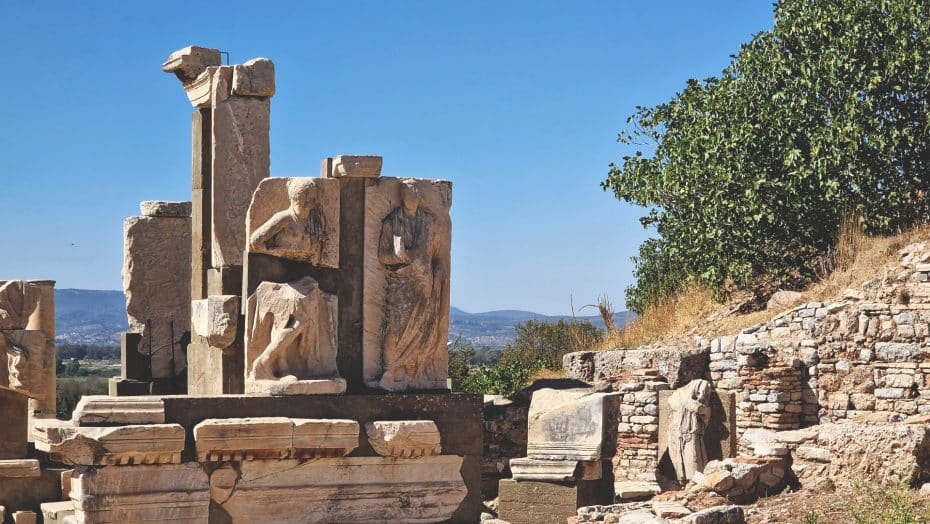
EThe Memmius Monument was built in the 1st century BC. New excavations have discovered pipes very close to the monument, which could indicate that it was an ornamental fountain.
7. Curetes Street
Curetes Street is Ephesus’s main street. It connects the city’s lower half with the upper half. It runs between the Library of Celsus and the Gate of Heracles. Many of Ephesus’s historical buildings, including the Town Houses, are located on Curetes Street.
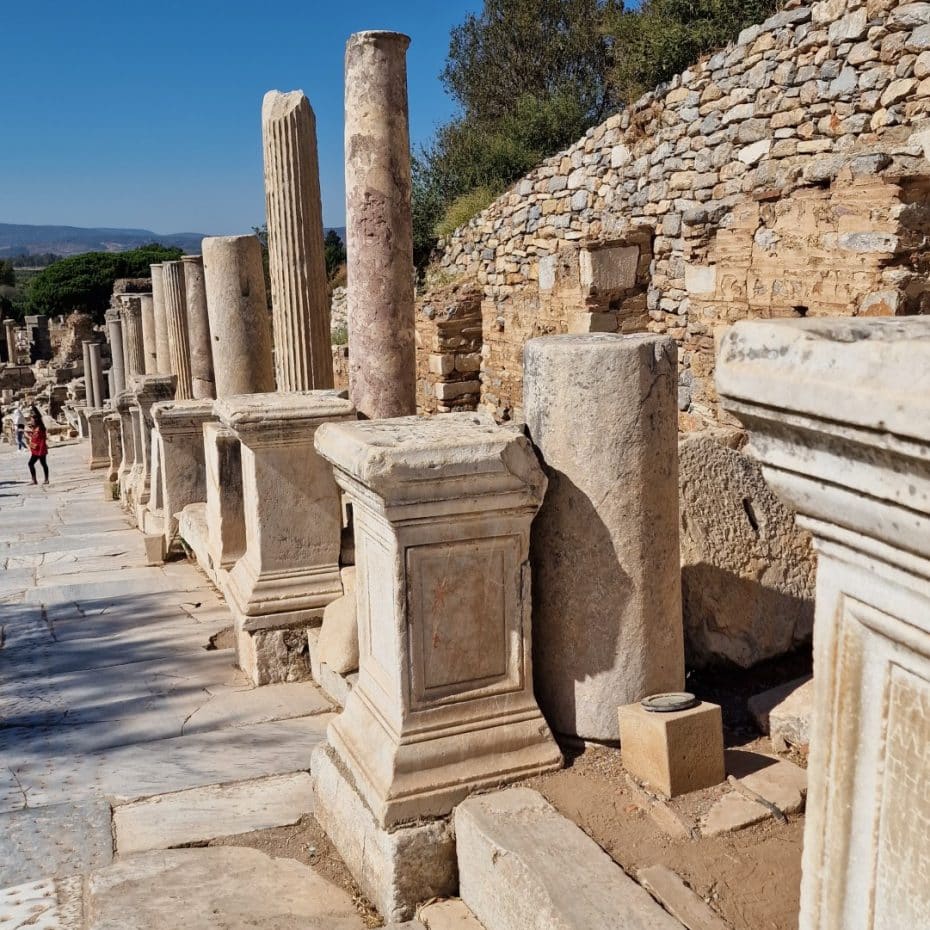
Curetes Street was the center of activity in ancient Ephesus. On both sides were mansions, shops, galleries, monuments, and fountains.
8. Nike of Ephesus
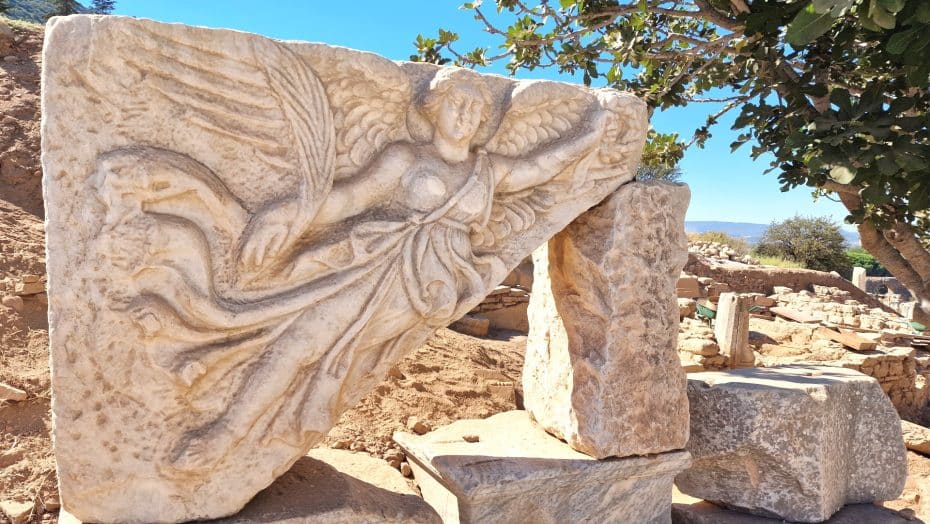
One of the most photographed attractions in Ephesus is the Nike sculpture in Domitian Square.
The famous sculpture is a triangular-shaped marble relief featuring Nike, the Greek goddess of victory. Nike holds a laurel wreath in one hand and a palm branch in the other.
This Nike relief once crowned the Gate of Heracles but is now found to its side. It is one of the best places in Ephesus to take a selfie.
9. Gate of Heracles
The gate is located at the beginning of Curetes street.
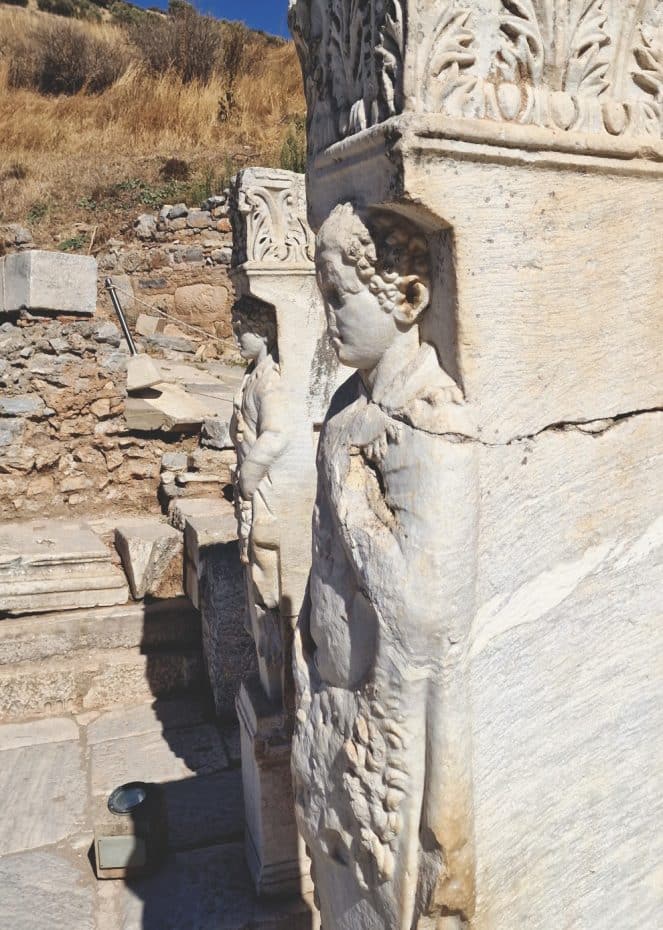
Two sculptures representing Heracles are visible on both columns. It is a gate that divides the upper city of Ephesus. In this door was located the frieze of the goddess Nike.
10. Trajan Fountain
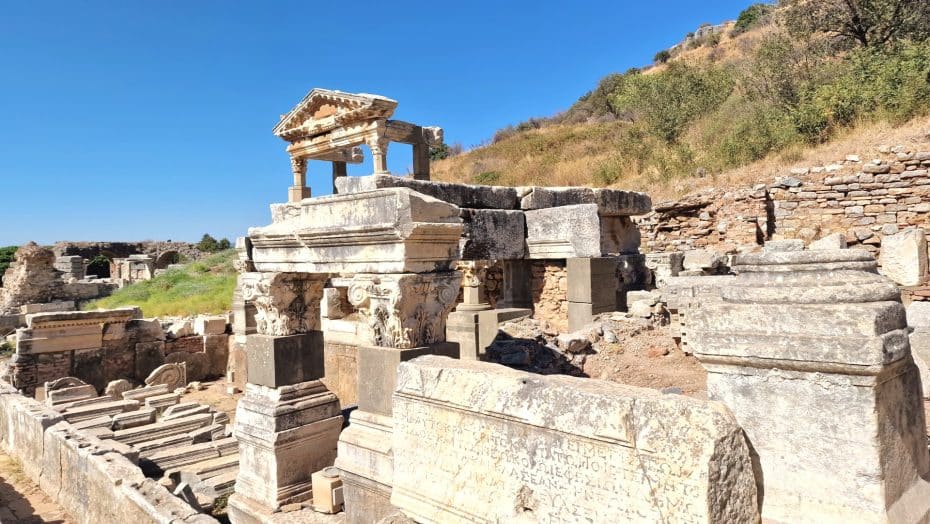
It is the only monumental fountain in Ephesus built for a Roman emperor. It is located on Curetes street and was built at the beginning of the 2nd century. It is nine and a half meters (30 ft) high and has two floors. It was dedicated to the emperor Trajan and the goddess Artemis.
11. Hadrian’s Temple
Hadrian’s Temple is one of the best things to see in Ephesus.
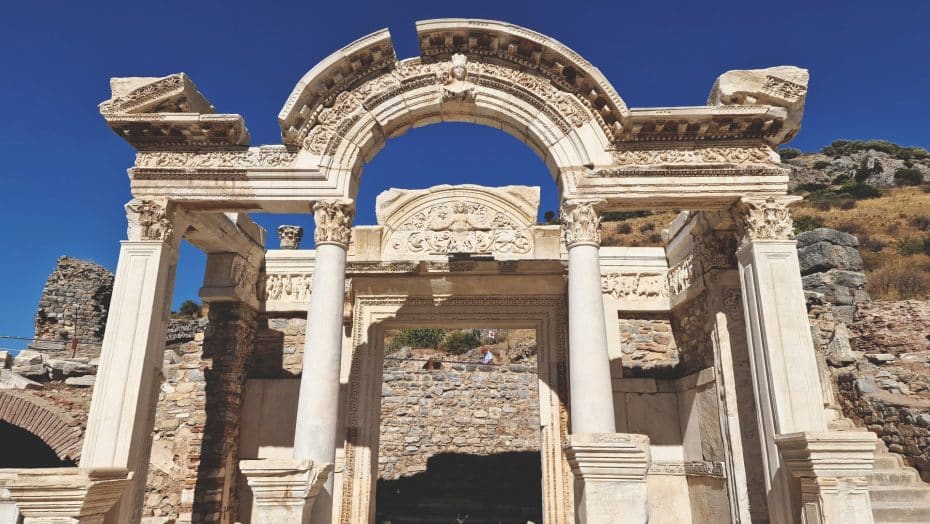
Located on Curetes Street, the temple dates back to the 2nd century, and it was built in honor of Roman Emperor Hadrian.
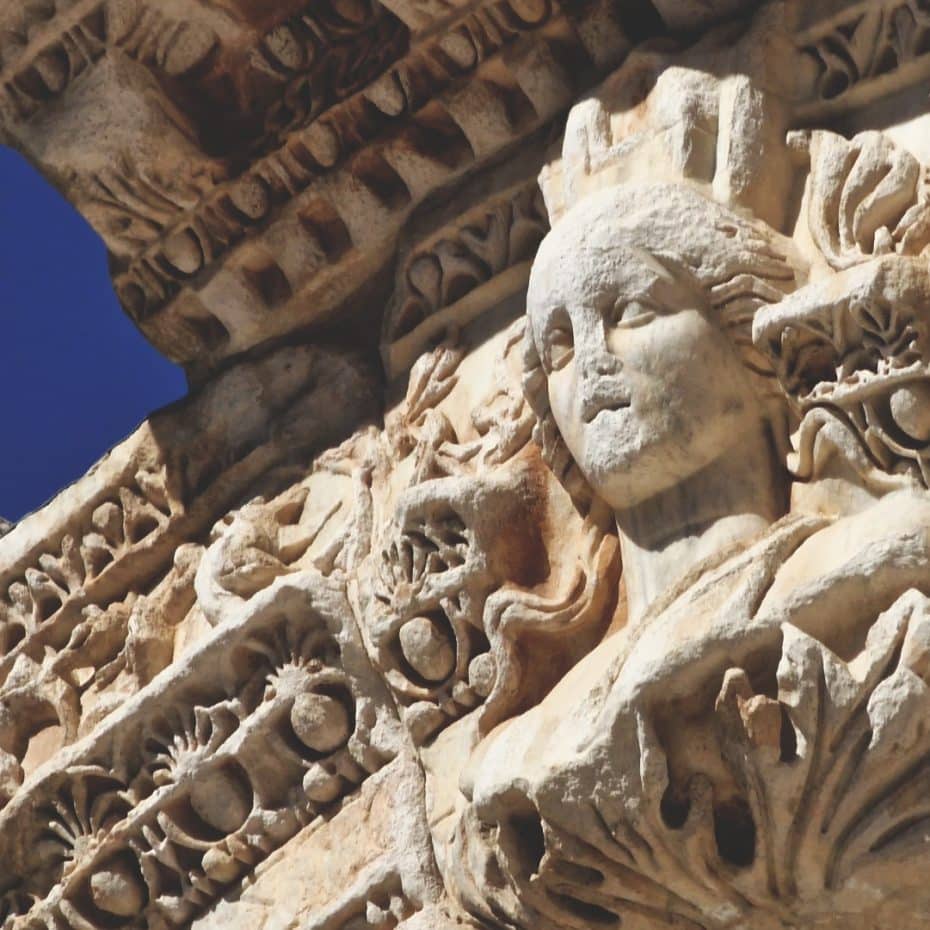
Don’t miss the relief on the door lintel depicting events at the founding of Ephesus.
12. Terrace Houses
The terraced houses in Ephesus can be visited by buying a separate 50 Turkish Lira ticket, so if you want to visit them, make sure you buy the tickets at the ticket office.
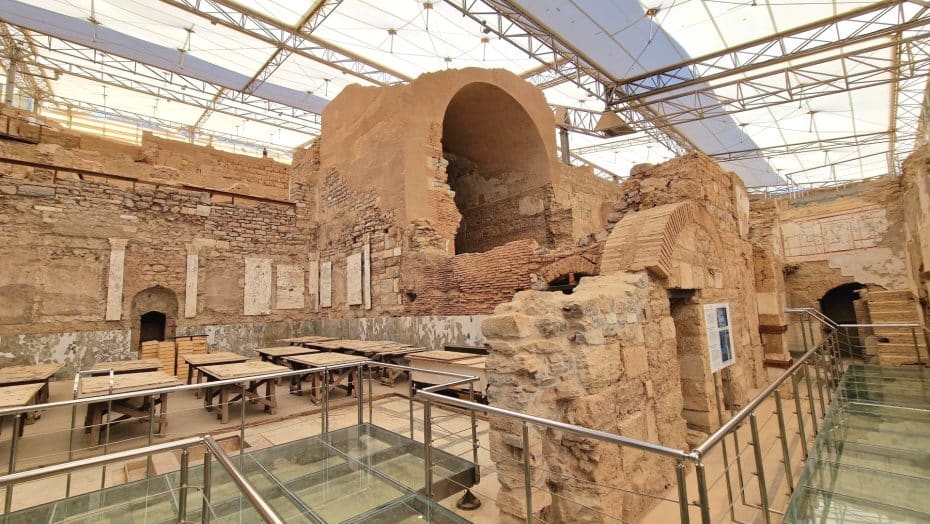
These houses have been excavated over the last few decades and give you an excellent example of how the wealthy people of Ephesus lived. With six fully excavated houses, the extra ticket is definitely worth it.
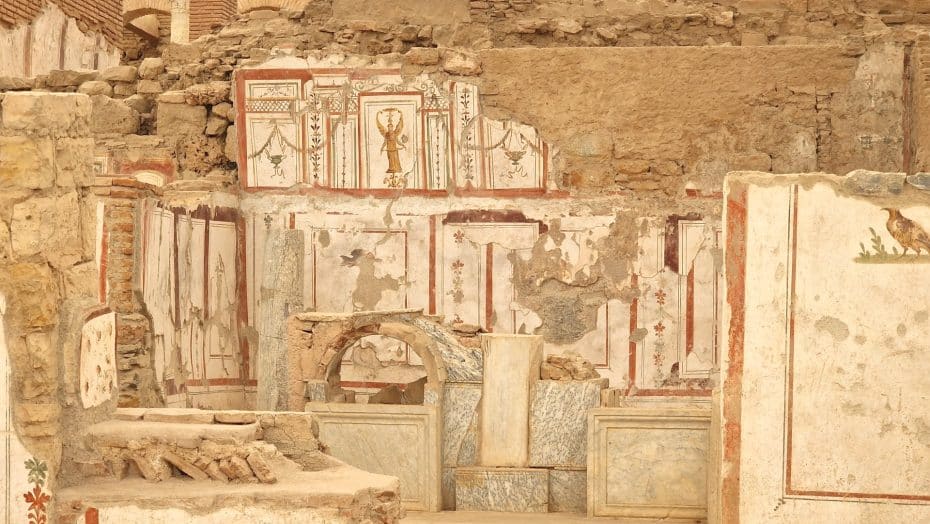
The houses, used from the 1st to the 7th century AD, are connected by modern glass walkways, beginning at a sizeable mosaic-floored portico. In ancient times, behind the entrance would be the shops and then the brick single-family homes with red tile roofs.
The family rooms were arranged around a central patio that you will be able to see during your visit. The balconies and windows of the houses were oriented towards the interior of the courtyard (and not towards the street) to keep the homes safe from thieves.
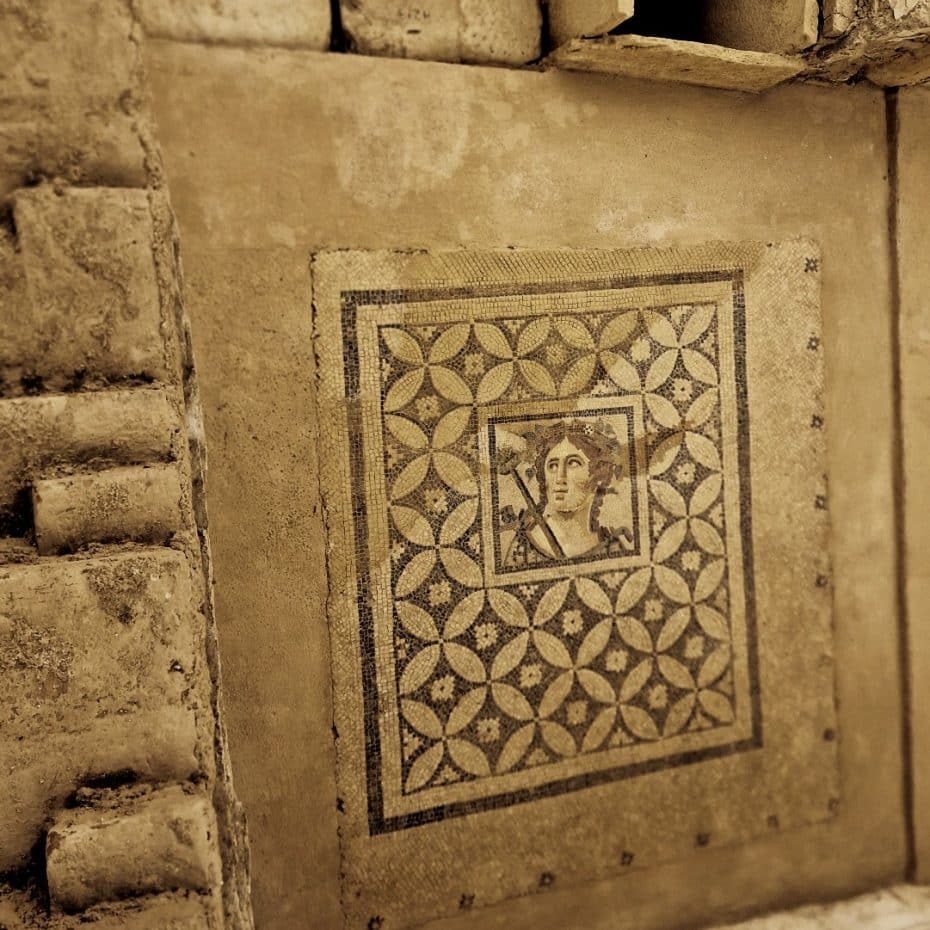
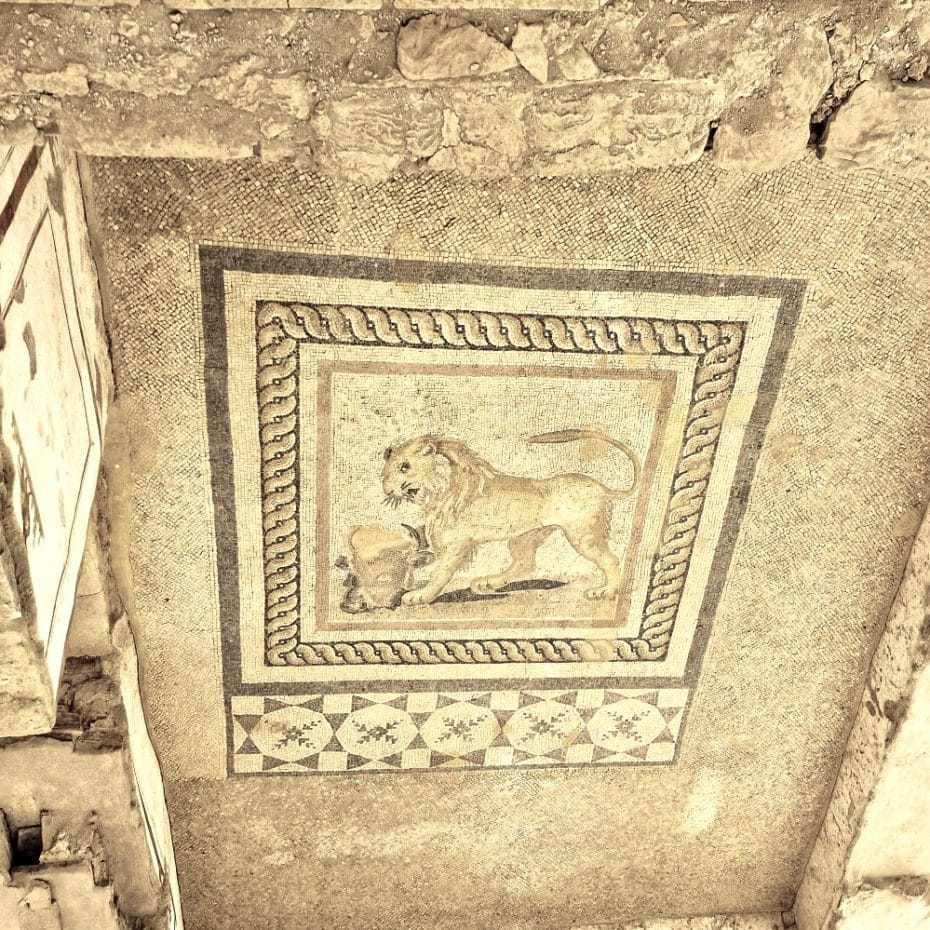
Asegúrate de detenerte y apreciar los mosaicos de los suelos y frescos de las paredes, son realmente una maravilla.
13. Library of Celsus
The Library of Celsus is one of the most majestic buildings of the Roman Empire and the third largest library in the ancient world after those of Alexandria and Pergamon.
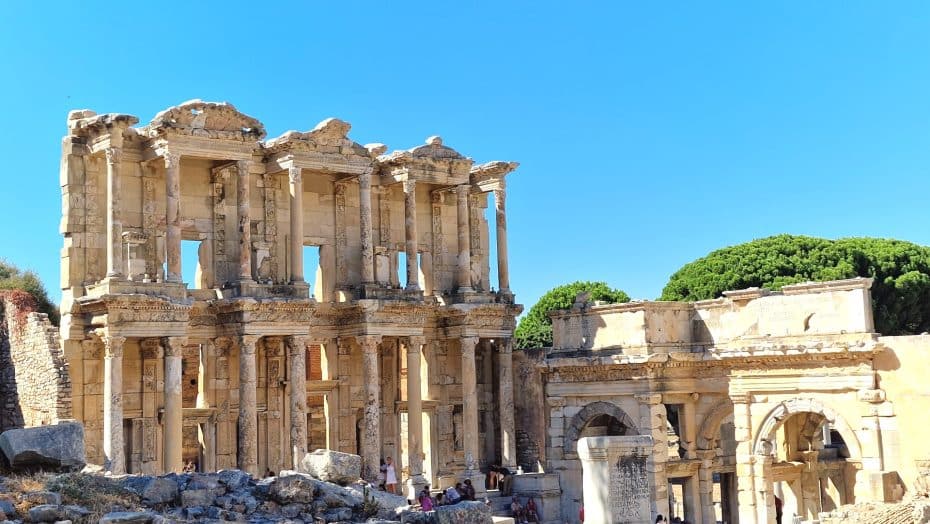
Built in the 2nd century AD. By Tiberius Julius Celsus Polemaeanus, a notable member of the Roman senate, the Library of Celsus once housed more than 12,000 books. Later, it also became the burial place of Celsus.
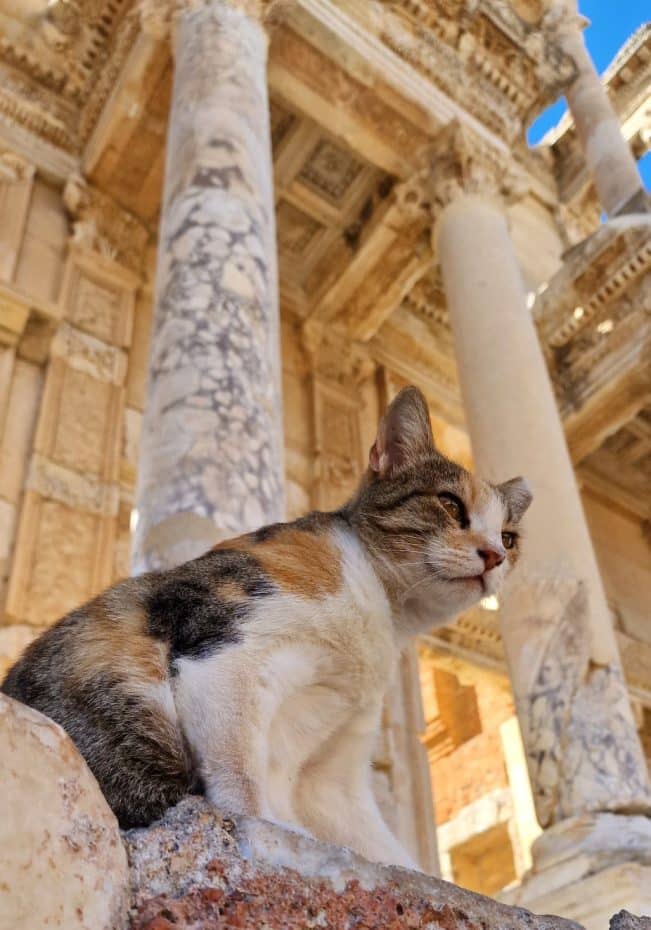
The Library of Celsus offers a majestic arched entrance with two levels and highly ornate facades. Four pairs of Corinthian columns adorn the three doors of the library. Each of the doors has an elaborate frame and a large window at the top.
Four statues flank the doors. They represent the four qualities of Celsus Polemaeanus: wisdom, intelligence, knowledge, and virtue.
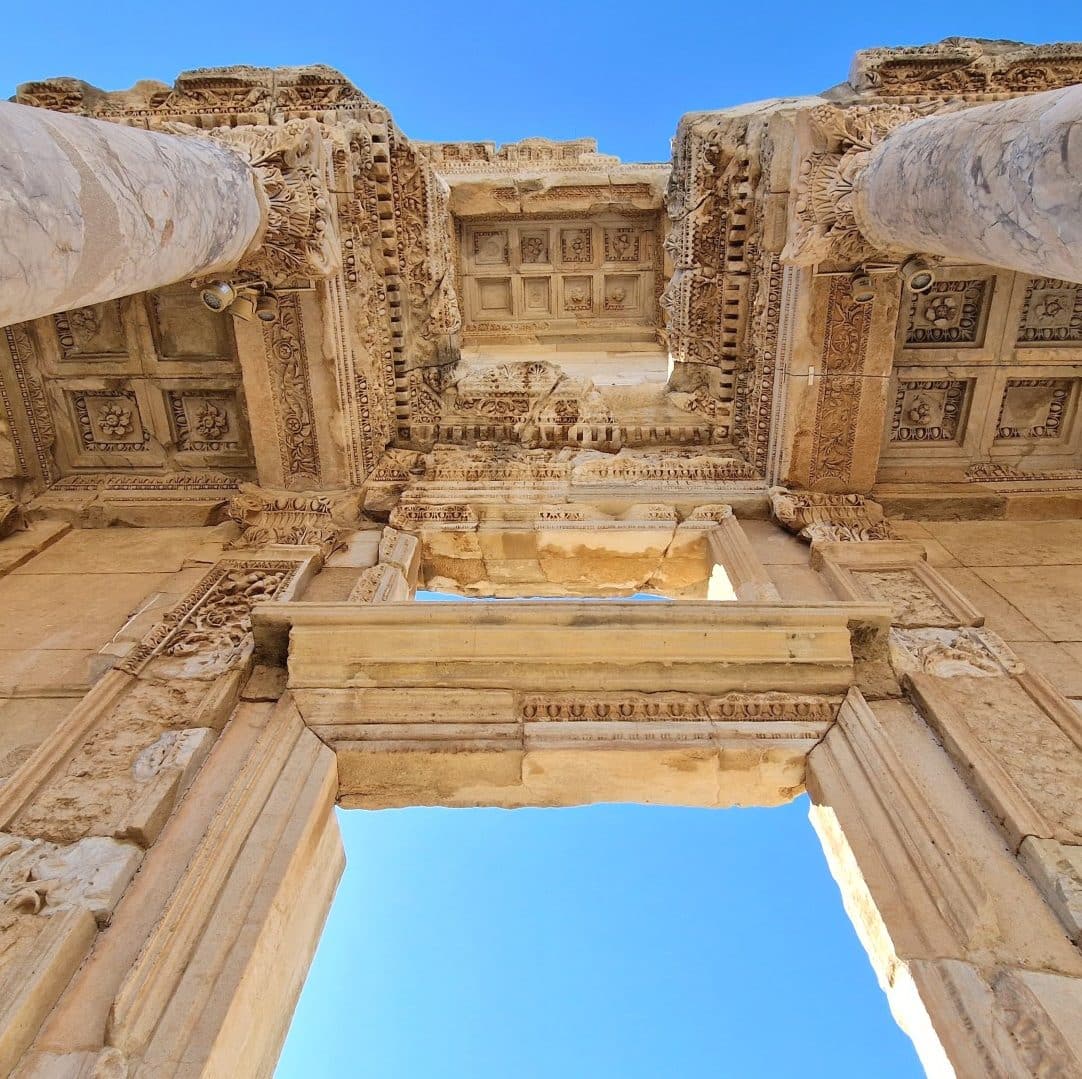
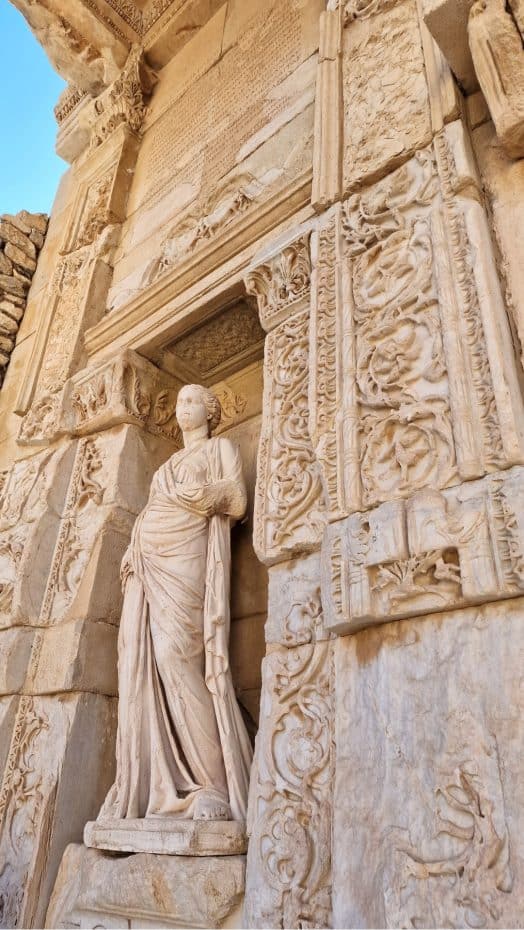
14. Gate of Mazaeus and Mithridates
This gate is located next to the Library of Celsus and opens onto the Agora.
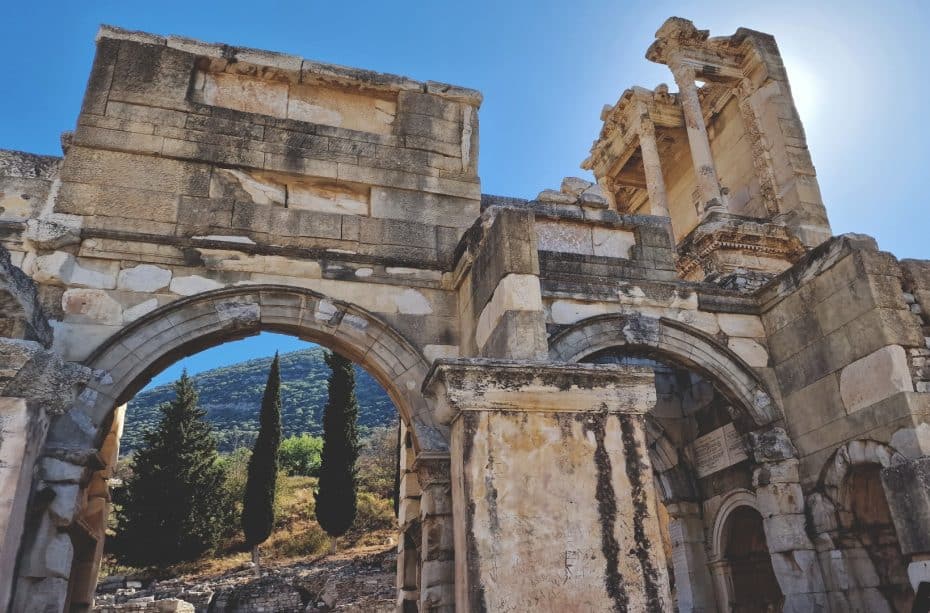
It was built by Mazaeus and Mithridates 2000 years ago for the Roman Emperor Augustus. Mazaeus and Mithridates were both architects who became slaves to the imperial family of Augustus.
15. Commercial Agora
It is one of the two Agoras located in Ephesus. With more than 11,000 square meters, this large shopping square had stores on all four sides.
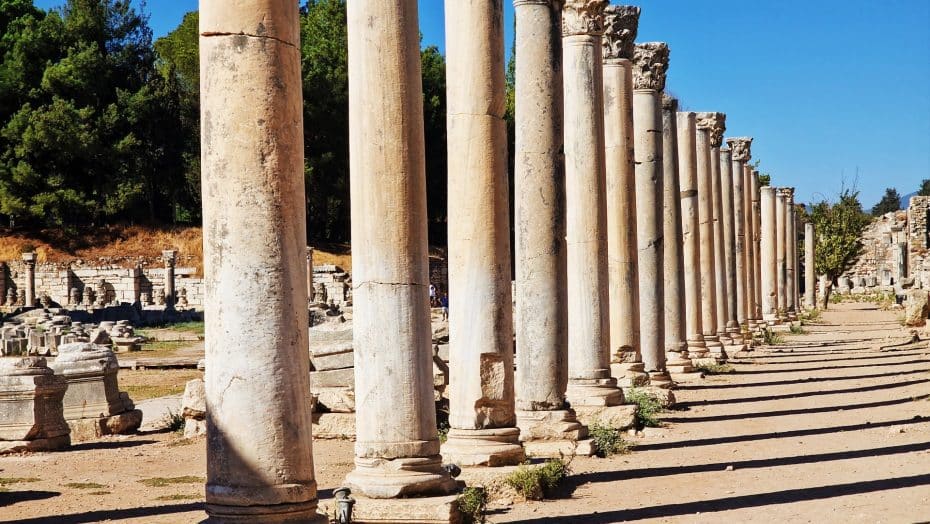
It was built during the Hellenistic period, enlarged in the Roman period, and was the largest commercial area in the city.
Saint Paul is said to have worked as a tent maker in the Commercial Agora.
16. Great Theater
The Great Theater of Ephesus had a capacity of 25,000 seats.
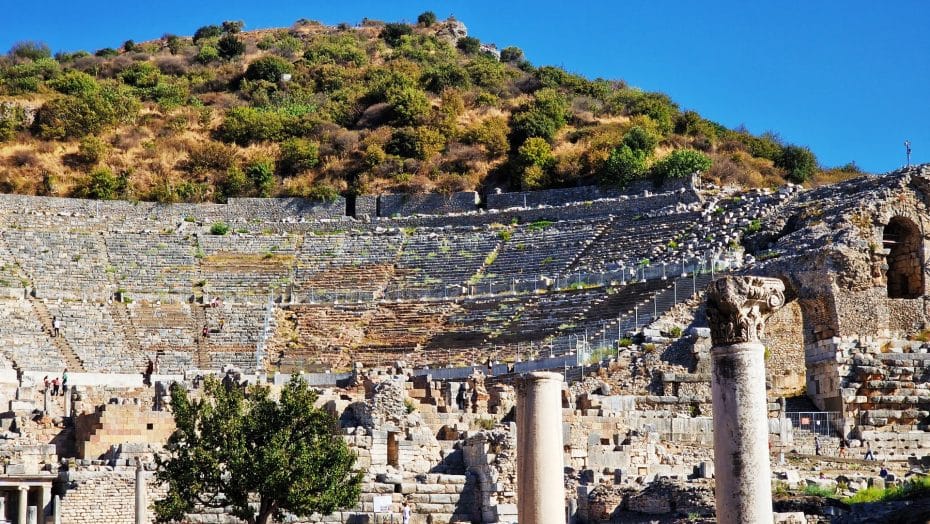
The Great Theater was a much smaller structure during Greek times. Later, the Romans rebuilt and enlarged it.
Gradually, the theater became a massive 3-story amphitheater that would soon become the center of Ephesus’ social life. Apart from the dramas and comedies, the Great Theater hosted numerous political assemblies and gladiator fights.
17. Church of Mary
Mary’s Church was an ancient Christian cathedral dedicated to the Theotokos (“Mother of God,” the Virgin Mary), located in Ephesus. It is also known as the Church of the Councils because it is supposed that two important councils for the history of Christianity were held inside it.
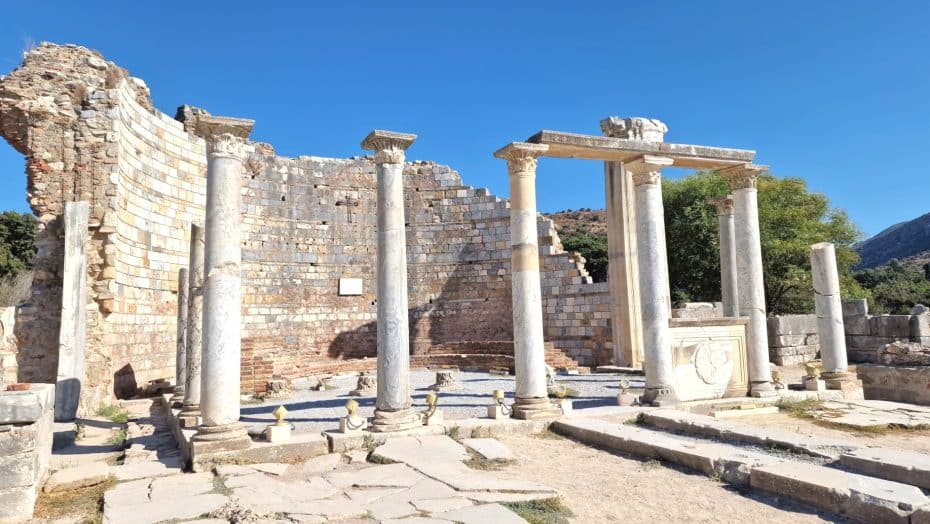
The Church dates to the early 5th century, coinciding with the Council of Ephesus, suggesting that it may have been built specifically for that Third Ecumenical Council, during which the title of Theotokos was bestowed to Mary.
The most recent archaeological evidence suggests that the Church was built on the ruins of an earlier Roman basilica-like building, abandoned around the 3rd century, known as the “Hall of the Muses.”
Around 500, the Church was enlarged into a monumental cathedral, the apse, and pillars, which are still partially on the site.
The Church served as a cathedral and was the seat of the bishopric of Ephesus throughout Late Antiquity.
Ephesus Travel Guide: Useful Info & Tips for Visiting Ephesus
Where Is Ephesus?
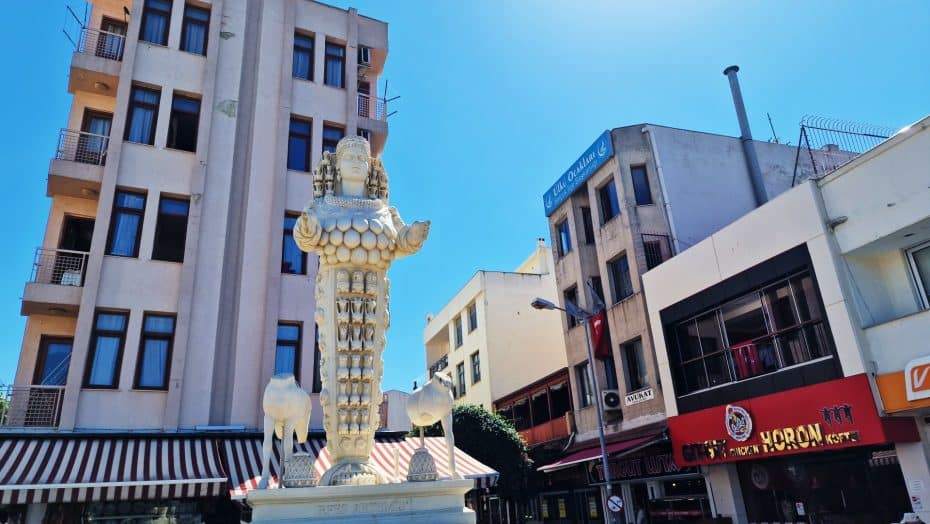
The ruins of Ephesus are located just a 5-minute drive from the small town of Selçuk, Turkey. Selçuk, located in the coastal province of Izmir, is an excellent base for visiting Ephesus and also boasts many other historical and cultural attractions, including the remains of the Temple of Artemis and the Church of Saint John.
What’s the Best Time to Visit Ephesus?
Like most places in Europe, the spring and autumn months are the best to visit Ephesus. It is advisable to plan your trip between March and May or September to November.
The months of June to early September can be scorching, with temperatures frequently exceeding 34°C (75ºF). In addition, these months coincide with school holidays in most of Europe and America, so the area is packed with tourists.
If you decide to visit Ephesus in winter, keep in mind that low temperatures can reach 4ºC (40ºF), so bring a jacket and long pants.
As for the best time of day to visit the Ephesus ruins, it is best to arrive in Ephesus as close to opening hours as possible. The large groups of tourists arriving from Kusadasi and Izmir arrive in buses around 10:00, filling up the place. Another option is to visit Ephesus during the golden hour, just before sunset.
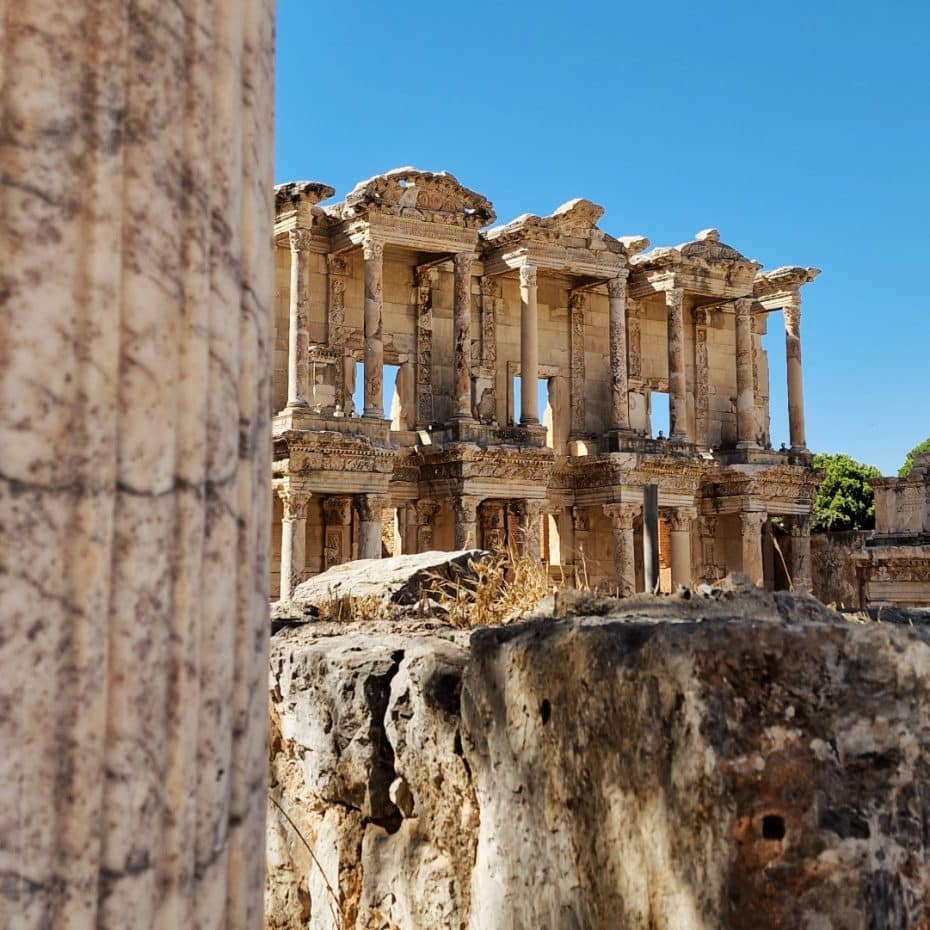
Above I have told you about the main attractions in Ephesus if you access the complex through the upper gate. If you decide to arrive early to avoid the tourists, ignore everything I’ve written, enter through the lower gate and head straight to the Library of Celsus. It is the most impressive area of the complex and the one that you will want to explore alone, even if only for a few minutes.
In any case, and even if you don’t have the ruins all to yourself, you can always do what I did in the photo above and use the available resources to make it look like it.
How Long Should I Spend Visiting Ephesus?
A day in Ephesus is a perfect time to visit the ruins.
Book a hotel in Selçuk for one night (two if you also want to visit the town and its many attractions) and visit the ancient city of Ephesus in the early hours of the next morning.
The visit to the ruins of Ephesus can take up to 2-4 hours in total.
Ephesus Archaeological Site: Opening Hours
The opening hours of the Ephesus site during the summer months (from April to the end of September) are from 8:00 a.m. to 06:30 p.m.
During the winter months (October to the end of March), Ephesus’s opening hours are from 8:30 a.m. to 5:30 p.m.
Keep in mind that ticket offices close one hour before closing time.
Getting to Ephesus
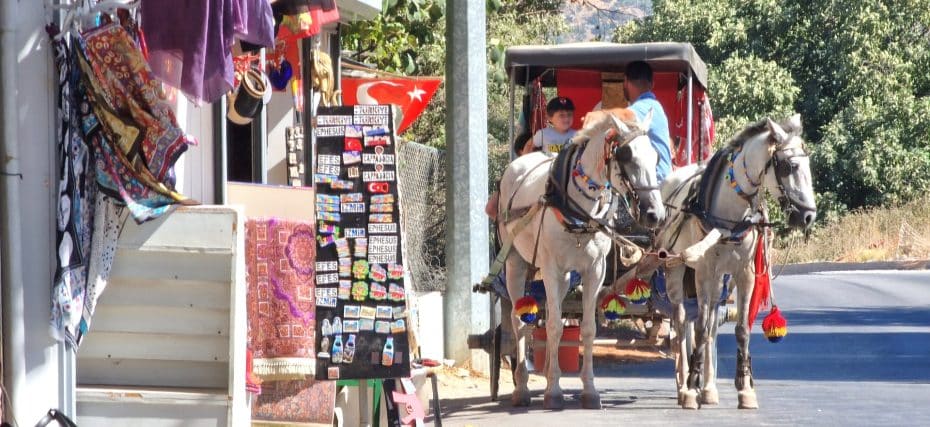
Getting to Ephesus is quite easy from places like Istanbul, Pamukkale or Izmir. Since Selçuk (the city where the ruins of Ephesus are located) enjoys a central location on Turkey’s southwestern coast and is a popular tourist attraction, you can reach Ephesus by car, bus, airplane or on an organized tour. Your mode of transportation will depend on where you are staying. These are your main options:
Getting to Ephesus from Izmir
By Car
The distance from Izmir to Ephesus is only 80 km (50 mi) and takes an hour (depending on traffic). Note that the fastest route, via the E87 road, has a toll. You can also book a private transfer from Izmir airport.
By Train
If you start your journey at Basmane Izmir railway station, you can catch one of the frequent services on the Izmir-Denizli route (they usually run every hour). The train journey from Izmir to Selçuk (Efes) takes about 80 minutes. Alternatively, there is a direct bus and commuter train service from Izmir airport to Selçuk.
By Bus
f you decide to go from Izmir to Ephesus on a quick bus ride, you will start your journey at the busy Izmir bus station. The journey from Izmir to Ephesus takes more than 2 hours due to stops at the villages along the way.
Getting to Ephesus from Istanbul
By Car
The best way to get from Istanbul to Ephesus is by booking a rental car. The journey takes about 5.5 hours and takes you on a scenic highway through cities like Bursa and Izmir.
Find a cheap rental car in Istambul at Rentalcars >>
By Plane
The Istanbul – Ephesus route can also be done by plane through the Izmir airport and then to Selçuk. Book a domestic flight from Istanbul to Izmir and then take a local bus to Selcuk (Efes) or commuter train directly from the airport.
Find a cheap flight from Istanbul to Izmir on Skyscanner >>
By Bus
The bus from Istanbul to Ephesus leaves from the Istanbul Central Bus Station and takes approximately 10 hours (with many stops along the way). The bus price from Istanbul to Ephesus costs about 25 dollars.
Find cheap bus tickets at BusBud >>
Getting to Ephesus from Pamukkale
By Car
If you are doing a Turkey itinerary by car, you can easily reach Ephesus from Pamukkale in about 3 hours on a well-maintained road.
Find rental car offers on Rentalcars >>
By Bus
You can take a bus from Denizli bus station to Selçuk. Denizli is about a 20-minute taxi ride from Pamukkale. The bus ride takes 3-4 hours, depending on how many stops you make. Be sure to look for the route from Denizli to Selcuk.
Find cheap bus tickets at BusBud >>
The Best Guided Tours to Visit Ephesus
If you’re in Istanbul, Izmir or Kusadasi, don’t have a car, or don’t have much time, I recommend you take a guided tour of Ephesus.
The good thing about an organized tour is that you have access to an expert guide who can give you a deeper insight into the history of Ephesus and the architectural aspects of specific attractions such as the Library of Celsus or the Terrace Houses.
If you’re staying in Selçuk, you won’t necessarily need to book a guided tour. The signage at the Ephesus ruins is quite descriptive, so a visit on your own is totally feasible if you take the time to stop and read the signs.
These are some of the best-rated and recommended tours from Istanbul, Kusadasi, and Izmir:
Ephesus Tours from Istanbul
Ephesus Tours from Kusadasi
Ephesus Tours from Izmir
Where to Stay When Visiting Ephesus
The most convenient place to stay near Ephesus is Selçuk, a 5-minute drive from the archaeological site. Please note that there are no hotels directly at the ruins of Ephesus; the closest city is Selçuk.
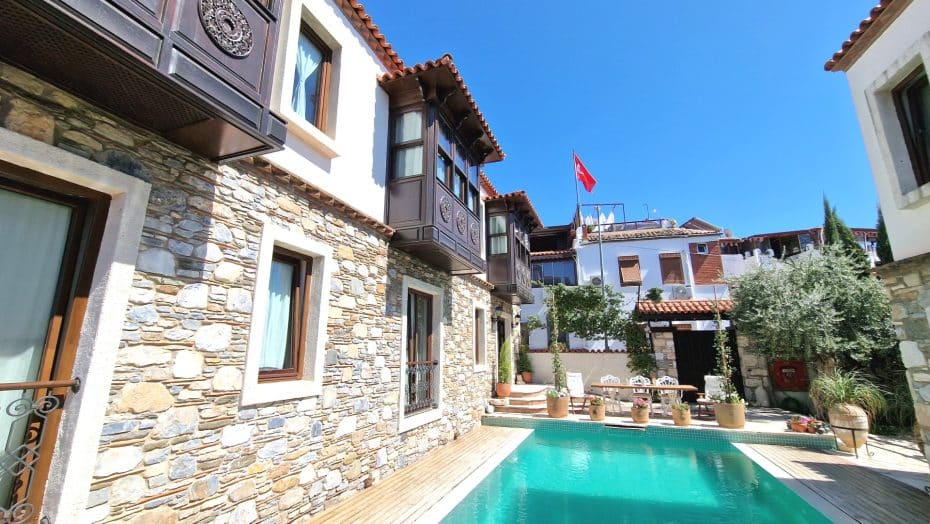
During my visit to Ephesus, I stayed at the Akanthus Hotel Ephesus, an excellent boutique-style family hotel located in the center of Selçuk.
Everything was amazing. The hotel is ideally located to explore Selçuk and not far from the site of Ephesus. The staff was accommodating and always had a smile on their faces. The room was beautiful and offered views of the old town. Comfortable beds, and everything was spotlessly clean.
Find out more on Booking.com >>
These are other accommodation options in Selcuk with an excellent rating on Booking.com:




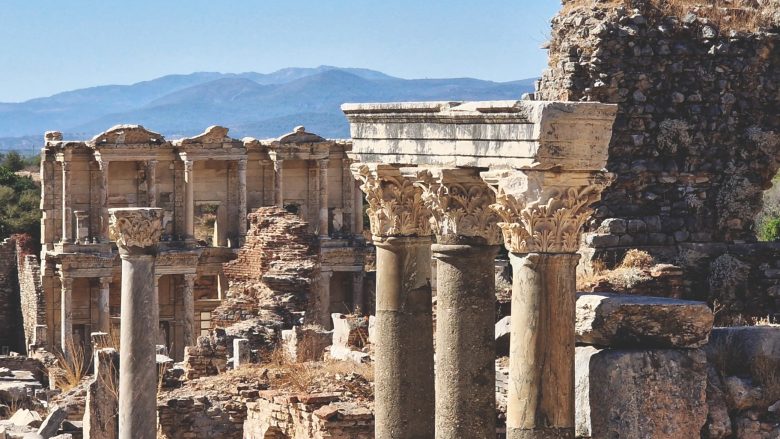

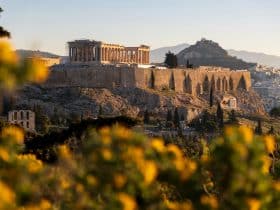
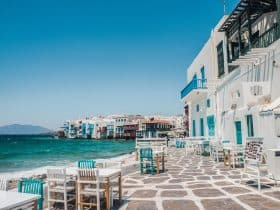





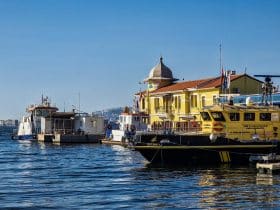
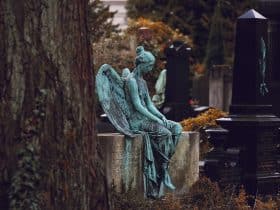



















Leave a Reply
View Comments